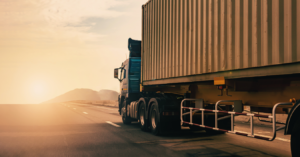The freight logistics and transportation sector is at a crossroads. On one hand, globalization has opened unprecedented opportunities for businesses to grow and deliver goods globally with sustainable freight logistics in mind. On the other, the environmental consequences of these activities are increasingly coming into sharp focus.
Enter the era of sustainable freight logistics—a necessity for any forward-thinking company. This guide explores how Nolan & Cunnings’ state-of-the-art sustainability solutions can help you make this transition smoothly and effectively.
Understanding Sustainable Freight Logistics
Defining Sustainable Logistics
Sustainable freight transport & logistics refers to managing and using freight transportation resources in a way that considers environmental and social impacts. The significance of sustainable practices in freight transport and logistics extends beyond just ‘going green.’ It also encompasses energy efficiency, lowering emissions, and optimizing resources, all while maintaining profitability.
Current Challenges and Statistics
Transitioning to a more sustainable freight logistics model isn’t without its challenges. High energy consumption, increased greenhouse gas emissions, and disruptions in existing operations make the shift difficult. According to the International Transport Forum, road freight is a major contributor to carbon dioxide emissions, accounting for about 35% of emissions from all modes of transport.
Setting Sustainability Goals
Before diving into the “how,” it’s crucial to understand the “what.” What are your objectives when it comes to sustainability? Setting goals like carbon emission reduction, use of renewable energy, and waste minimization is essential. Here, benchmarking and lifecycle analysis tools can yield valuable insights into your current standing and future targets.
Essential Components for a Sustainable Logistics Model
Emissions Reduction
Reducing emissions is the first significant step in any sustainable logistics model. Many technologies and optimization techniques are available, including more efficient engines, electric or hybrid vehicles, and aerodynamic modifications. Carbon offsetting programs can also help neutralize emissions.
Energy Efficiency
Energy-efficient operations can result in substantial costs saved while lowering a carbon footprint. Simple initiatives like LED lighting in warehouses or energy-efficient appliances can make a difference. Advanced logistics services software can also help in route optimization, reducing both fuel consumption and emissions.
Modes of Transport
The choice of transportation modes plays a critical role in determining the overall sustainability of logistics activities. While air freight may be convenient for speedy deliveries, it has a significant carbon footprint.
Conversely, sea and rail transport are much more energy-efficient options. For road transport, you can make a sustainable switch by transitioning to electric or hybrid vehicles, which substantially reduce greenhouse gas emissions compared to traditional fossil fuel-powered options.
Last-Mile Solutions
The “last mile” of delivery is often the most challenging regarding sustainability. This term means when innovative solutions such as electric delivery vehicles and drone deliveries come into play, they result in environmental benefits and cost reductions.
Technological Innovations and Real-Time Optimization
Advanced Software for Routing and Tracking
Nolan & Cunnings offers state-of-the-art transportation management software for real-time carrier collaboration and optimized route planning. Leveraging such advanced tools can significantly reduce fuel consumption and, by extension, emissions.
Real-Time Data Analysis for Decision-Making
Real-time analytics can provide insights into various aspects of the logistics chain, from transportation activities to warehouse management. This data enables companies to make quick, informed decisions that enhance efficiency and reduce environmental impact.
Carbon Offsetting and Mitigation
Options for Making Logistics Activities Carbon-Neutral
For emissions you can’t avoid, carbon offsetting is a practical option involving investing in environmental projects to balance your carbon footprint. Nolan & Cunnings can guide you in selecting the most effective carbon-offset strategies.
Types of Carbon-Offset Tactics
You can opt for reforestation projects, renewable energy initiatives, or community-based environmental programs as part of your offsetting strategy. These efforts not only mitigate your emissions but also contribute to social welfare.
Why Transitioning Is a Win-Win
Addressing the Costs
While transitioning to sustainable freight logistics might involve initial expenses, the long-term gains are worth it. Reduced energy bills, less waste, and operational efficiencies can save on costs.
Long-Term Benefits including Cost Savings and Brand Value
Beyond monetary savings, embracing sustainable practices can significantly enhance your brand image. In an age where consumers are increasingly eco-conscious, your commitment to sustainability can set you apart.
Conclusion
The transition to sustainable freight logistics is an environmental imperative and a smart business decision. With viable options for emission reduction, energy efficiency, and stakeholder collaboration, businesses stand to gain substantially in the long run.
Ready to Take the Next Steps Toward Sustainable Freight Logistics?
If you’re ready to take the next step in your sustainability journey, Nolan & Cunnings offers comprehensive solutions tailored to your needs. From real-time optimization to carbon offsetting, we have the tools and expertise to make your transition seamless and rewarding. Contact us today for a free consultation.

